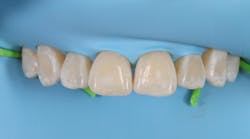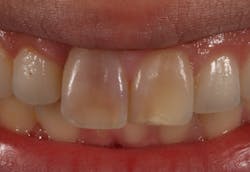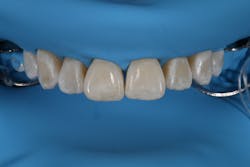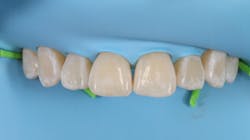Some tips for using an anterior rubber dam
• Remove decay first and then place the dam, especially if there is a chance that caries will progress subgingivally. This negates the need to replace the dam if it gets torn or shredded during caries removal with rotary instruments.
• Consider nonlatex rubber dams, as this lessens worries about contact dermatitis or other possible allergic reactions.
• A heavy rubber dam is preferred as it will not only isolate from crevicular fluid, but it will also retract the papilla, allowing access to the subgingival areas. This is important not only for caries removal, but also procedures when emergence profiles need to be addressed, such as black triangle resolutions or diastema closures. Figure 1Also by Dr. Volker:
• Even if only one tooth is being restored, it is often better to isolate several teeth adjacent to the one being restored. This will lessen the tension on the target tooth, making it easier to invert. If incisors will be treated, the dam is typically placed from first premolar to contralateral premolar.• A custom dam can be created by placing the dam over the teeth with enough tension to allow the outline of the teeth to be seen. The assistant can then mark the center of the incisal edge of the incisors with a pen or marker. Similarly, mark the tip of the cuspid and the buccal cusp tip of the premolars, and punch the holes. This is useful for teeth that may be rotated or mispositioned within the arch form.
• It is often unnecessary to anesthetize all the teeth to be isolated. Place a topical anesthetic on all teeth; place the rubber dam over the teeth and invert. To affix the dam, premolar clamps can be placed over it (figure 3). Alternatively, a rubber cord, such as Coltene’s Wedjets, can be flossed between the contact of the most distal teeth to be isolated and left in place (figure 4).• If single-tooth isolation is preferred, or needed for root canal therapy, a 210, 211, 212, 90N, or Brink B4-B6 can be considered. Clamp tines can be bent as needed for enhanced access to the operative field.
Editor’s note: This article first appeared in Through the Loupes newsletter, a publication of the Endeavor Business Media Dental Group. Read more articles and subscribe to Through the Loupes.











